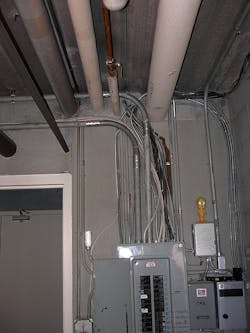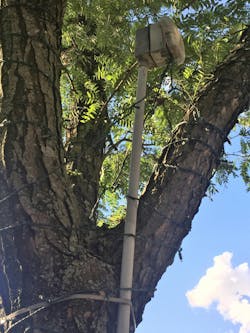All references are based on the 2023 edition of the NEC.
Dedicated Space Violation
The plumbing pipes located directly above this enclosed panelboard show a great way to violate the dedicated space requirements of Sec. 110.26(E). With no leak protection apparatus installed to protect the electrical equipment, any leak of water or other fluids into the electrical equipment could cause a sudden and catastrophic failure.
According to Sec. 110.26(E)(1)(a), the space directly below and directly above this enclosed panelboard is reserved for electrical installations. This “dedicated electrical space” extends from the floor to a height of 6 ft above the panelboard enclosure or to the structural ceiling — whichever is lower. Only electrical equipment can be installed in this space. Foreign systems, such as plumbing and heating pipes, HVAC ductwork, drains, oil lines, and even leak protection apparatus, are prohibited from being installed in this space. The area above the “dedicated electrical space” is permitted to contain these foreign systems, provided some type of protection against leaks or breaks in those foreign systems is provided for the electrical equipment.
Another problem is the improper supporting methods used for the NM cables entering the top of the panelboard enclosure. These cables are not properly secured and supported in accordance with Sec. 334.30. Using the EMT raceway to support the NM cables is a violation of Sec. 358.12(2) and does not comply with Sec. 300.11(C).
A Submarine Periscope Imitation?
This run of rigid PVC conduit and the outlet box reminds me of a submarine periscope rising up and out of the submarine. I doubt that was what the installer was hoping for though.
Using rigid PVC conduit as the only support for the outlet box is a violation of Sec. 352.12(B). Plugging cords into the receptacle installed in the box will cause the box to move around and the conduit to bend unless the user holds the box firmly in place while plugging or unplugging any cords. This continued bending and flexing of the conduit could eventually lead to failed joints or conduit damage. Section 314.23(A) through (H) provides lots of Code-compliant options for supporting boxes. Unfortunately for this installer, none of those options include using rigid PVC conduit as a supporting means.
The cover for the box is not completely closed and may not fully provide for an enclosure that complies with Sec. 406.9(B). In wet locations, 15A and 20A, 125V and 250V receptacles need to be installed in an enclosure that is weatherproof whether or not any attachment plug cap is plugged in. This unlatched cover can flap in the wind and allow rain to damage the receptacle during rainstorms.






